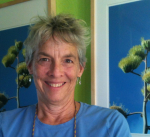 Drawing in a new medium might be your inventive step. Think outside your usual constraints.
Drawing in a new medium might be your inventive step. Think outside your usual constraints.
INVENTION!
The next step in making a study (see the past two posts for more information) is the big, fun one of actually doing something with all that brainstorming, experience and research. This is, of course, the point of it all. But even if you shortcircuit the PRIMING and just take one or two of my previous suggestions, you will end up with a much deeper, more resonant and powerful piece of work in the invention stage.
If you have the time and inclination -- and the deadline isn't looming -- here are some of the INVENTION exercises we use with kids, and that I use in my fiber arts creativity courses. These activities may not be exactly in your comfort zone, but that's the point. Whatever textile art (or other art) you create after playing in these ponds will be rich, rich, rich.
INVENTION
After the priming experiences, choose and play with materials in one or more of the following ways, and then express your own version or personal definition of the subject as uniquely as possible. You may have other suggestions or ideas for media or genres. This is just a wildman version of ways you can take your ideas!
Movement Play
Use some or all of your bodies and/or locomotion (movement from one spot to another) to explore the subject, and then create one or more of the following:
- · Physical games
- · Dances
- · Pantomimes
- · Dramas
- · Improvisations
2-D Play
Use the subject to create one or more of the following:
- · Drawings -- on canvas, paper and fabric
- · Paintings -- on canvas, paper and fabric
- · Collages -- fibric, mixed media, paper cloth
- · Prints -- screen, stencils, stamps
- · Art Quilts
- Art Cloth
- · Maps, graphs or diagrams
- · Stories or poems related to your drawings
3-D Play
Use the subject to create one or more of the following:
- · Puppets
- · Masks
- · Models
- · Sculptures
- · Constructions
- · Stories, dramas, environments or exhibits related to your creations
Word Play
Generate words related to the subject and use the words to create:
- · Stories (written or tape recorded)
- · Poems
- · Tongue twisters
- · Monologues/dialogues
- · Slogans
- · Invented words and definitions
- · Riddles
- · Books or a library of books
Tech Play
Use technology to create with the subject, creating one or more of these:
- · Slide shows of photographs
- · Transparencies on the overhead projector
- · Videos
- · Animations
- Digital books
- Photos to print on fabric
If you'd like to have a guide through this process, and you live somewhere near San Antonio, consider taking my course at the Southwest School of Art. The first four weeks of the course will be devoted to Making a Study.
Next blog: REFLECTING
 Tuesday, January 15, 2013 at 09:24PM
Tuesday, January 15, 2013 at 09:24PM 









